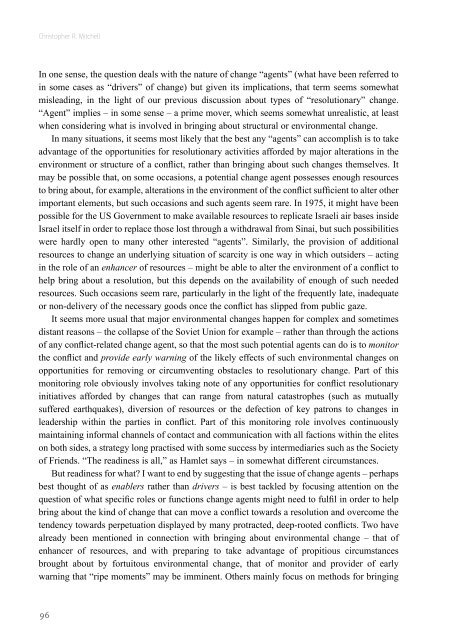Conflict, Change and Conflict Resolution - Berghof Handbook for ...
Conflict, Change and Conflict Resolution - Berghof Handbook for ...
Conflict, Change and Conflict Resolution - Berghof Handbook for ...
You also want an ePaper? Increase the reach of your titles
YUMPU automatically turns print PDFs into web optimized ePapers that Google loves.
Christopher R. Mitchell<br />
In one sense, the question deals with the nature of change “agents” (what have been referred to<br />
in some cases as “drivers” of change) but given its implications, that term seems somewhat<br />
misleading, in the light of our previous discussion about types of “resolutionary” change.<br />
“Agent” implies – in some sense – a prime mover, which seems somewhat unrealistic, at least<br />
when considering what is involved in bringing about structural or environmental change.<br />
In many situations, it seems most likely that the best any “agents” can accomplish is to take<br />
advantage of the opportunities <strong>for</strong> resolutionary activities af<strong>for</strong>ded by major alterations in the<br />
environment or structure of a conflict, rather than bringing about such changes themselves. It<br />
may be possible that, on some occasions, a potential change agent possesses enough resources<br />
to bring about, <strong>for</strong> example, alterations in the environment of the conflict sufficient to alter other<br />
important elements, but such occasions <strong>and</strong> such agents seem rare. In 1975, it might have been<br />
possible <strong>for</strong> the US Government to make available resources to replicate Israeli air bases inside<br />
Israel itself in order to replace those lost through a withdrawal from Sinai, but such possibilities<br />
were hardly open to many other interested “agents”. Similarly, the provision of additional<br />
resources to change an underlying situation of scarcity is one way in which outsiders – acting<br />
in the role of an enhancer of resources – might be able to alter the environment of a conflict to<br />
help bring about a resolution, but this depends on the availability of enough of such needed<br />
resources. Such occasions seem rare, particularly in the light of the frequently late, inadequate<br />
or non-delivery of the necessary goods once the conflict has slipped from public gaze.<br />
It seems more usual that major environmental changes happen <strong>for</strong> complex <strong>and</strong> sometimes<br />
distant reasons – the collapse of the Soviet Union <strong>for</strong> example – rather than through the actions<br />
of any conflict-related change agent, so that the most such potential agents can do is to monitor<br />
the conflict <strong>and</strong> provide early warning of the likely effects of such environmental changes on<br />
opportunities <strong>for</strong> removing or circumventing obstacles to resolutionary change. Part of this<br />
monitoring role obviously involves taking note of any opportunities <strong>for</strong> conflict resolutionary<br />
initiatives af<strong>for</strong>ded by changes that can range from natural catastrophes (such as mutually<br />
suffered earthquakes), diversion of resources or the defection of key patrons to changes in<br />
leadership within the parties in conflict. Part of this monitoring role involves continuously<br />
maintaining in<strong>for</strong>mal channels of contact <strong>and</strong> communication with all factions within the elites<br />
on both sides, a strategy long practised with some success by intermediaries such as the Society<br />
of Friends. “The readiness is all,” as Hamlet says – in somewhat different circumstances.<br />
But readiness <strong>for</strong> what? I want to end by suggesting that the issue of change agents – perhaps<br />
best thought of as enablers rather than drivers – is best tackled by focusing attention on the<br />
question of what specific roles or functions change agents might need to fulfil in order to help<br />
bring about the kind of change that can move a conflict towards a resolution <strong>and</strong> overcome the<br />
tendency towards perpetuation displayed by many protracted, deep-rooted conflicts. Two have<br />
already been mentioned in connection with bringing about environmental change – that of<br />
enhancer of resources, <strong>and</strong> with preparing to take advantage of propitious circumstances<br />
brought about by <strong>for</strong>tuitous environmental change, that of monitor <strong>and</strong> provider of early<br />
warning that “ripe moments” may be imminent. Others mainly focus on methods <strong>for</strong> bringing<br />
96
















